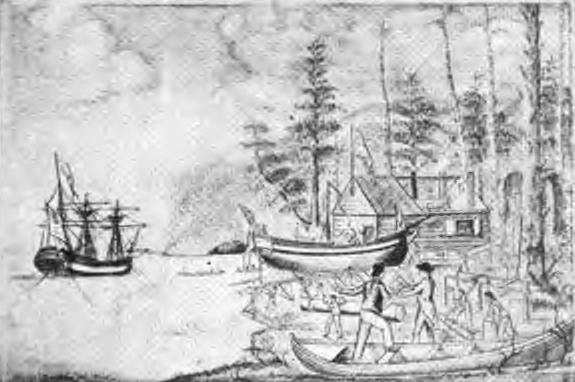Constructed: 1791-1792 | Continent: North America Abandoned: 1792 | |
 | ||
Previous Ownership: Wickaninnish chief of the Tla-o-qui-aht | ||
Fort Defiance was a small outpost built by the crew of the Columbia Rediviva for use as winter quarters during 1791-1792 on Meares Island in present-day British Columbia, Canada. They were under the command of American merchant and maritime fur trader Captain Robert Gray.
Contents
History
In early August 1791, John Kendrick had arrived in Clayoquot Sound and bought land from Wickaninnish in exchange for firearms. The land was near the native village of Opitsaht. By the time Gray arrived on the Columbia Redivia in late August for trading, Kendrick had fortified a small island and given it the name Fort Washington. Kendrick soon left for China, while Gray remained for the winter. For most of the winter relations with Wickaninnish and his people were good. On Christmas Day Wickaninnish and a number of other chiefs dined aboard the Columbia, and on New Year's Day, the Americans were entertained onshore by the natives.
Construction
The men of the Columbia began building their winter quarters on September 21, 1791. They completed the main building by September 30. This structure measured 36 feet (11 m) long by 18 feet (5.5 m) wide and was two stories tall. Fort Defiance also had a brick fireplace, as the traders had brought with them 5,470 bricks from Boston. The main building had two cannons mounted and musket loop holes for defending against native attacks. Additionally, other buildings constructed included a blacksmith shop, two sawpits for cutting logs, cabins, and a boat builder's shed. Once the fort was complete, four cannons, 40 muskets, and various other weapons were transferred from the Columbia; Robert Haswell was placed in charge of the base and ten men. At this point, the crew at Fort Defiance began construction of the ship Adventure, which skeleton had been brought aboard the Columbia.
Use
On October 3 the keel was laid for the ship. Over the winter the ship slowly began to take shape. On February 23, 1792, the ship was launched, making it the first American-built vessel in the Pacific Northwest. Once the ship sailed in March, the Americans abandoned their fort. Gray did not want to leave anything of value for the natives and had Haswell remove everything usable.
Destruction of Opitsaht
During the winter, Gray and his men had foiled an attack conceived by the Tla-o-qui-aht people and a Sandwich Islander of his own crew. In retaliation, as his forces were leaving the area, Gray ordered the destruction of 200 homes in the local village of Opitsitah (Opitsaht). The keeper of his ship's log noted that Gray had let his passions go too far.
Location
The crew built these winter quarters on Disappointment Inlet (now called Lemmens Inlet) on Meares Island, which is in Clayoquot Sound just north of Tofino. At the inlet, Fort Defiance was on the eastern side where the geography could provide natural defenses against attacks. Gray named the place Adventure Cove. Researchers identified the site of the former post in 1966 and the name was officially adopted by British Columbia in 1975. At the same time the little island in the cove, which Kendrick had fortified, was named Columbia Islet. Fort Defiance was on the mainland of Meares Island. Today it is a protected 135-acre (0.55 km2) archaeological site.
